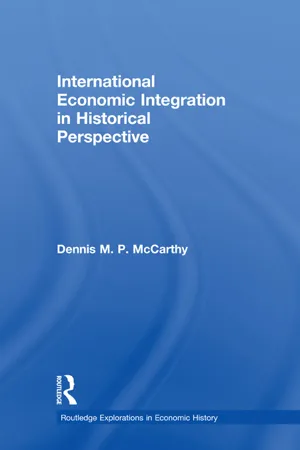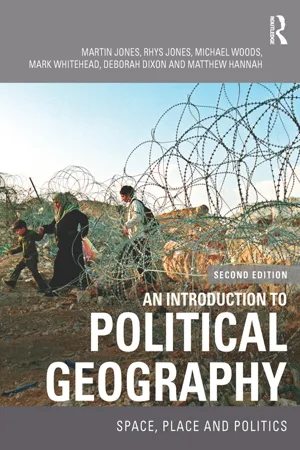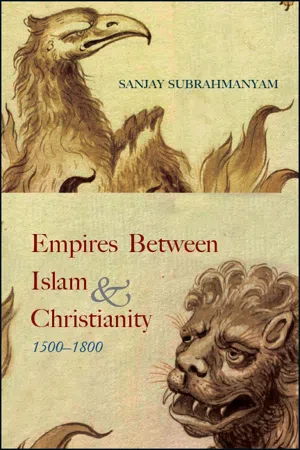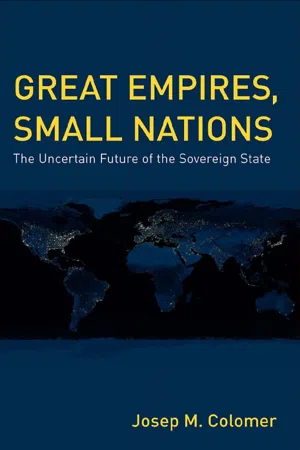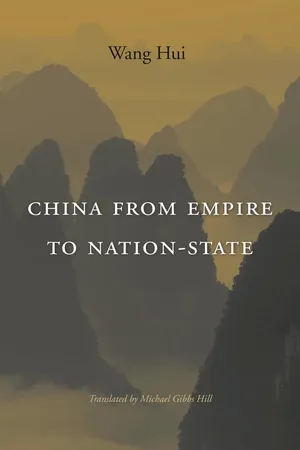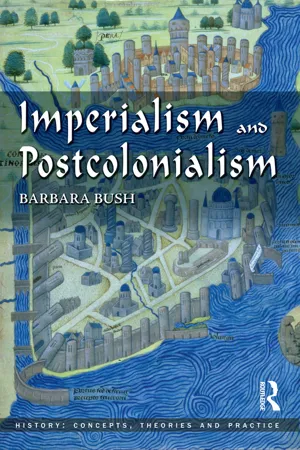History
Types of Empire
Empires can be categorized into different types based on their governance and territorial control. Some common types include territorial empires, maritime empires, and commercial empires. Territorial empires expand through conquest and direct rule, while maritime empires rely on naval power and control of sea trade routes. Commercial empires focus on economic dominance through trade and investment rather than territorial expansion.
Written by Perlego with AI-assistance
Related key terms
Related key terms
1 of 4
Related key terms
1 of 3
11 Key excerpts on "Types of Empire"
- Dennis Patrick McCarthy(Author)
- 2006(Publication Date)
- Routledge(Publisher)
1 Colonial EmpiresImperialism and Colonialism: Types, Causes, and FormsMany colonial empires have come and gone over the last 2,000 years. Colonial empires are associated with colonialism, which is directly related to imperialism. Imperialism is a broad term that encompasses whatever leads some people to dominate others. Imperialism pertains to an empire as a whole, whereas colonialism focuses on the individual colonies that an empire possesses. Colonies are the territories seized by an empire and can become administrative units of it.Imperialism has many causes. The drive to acquire power, money, wealth, or territory can be rooted in economic, business, political, religious, social, psychological, and cultural considerations. An empire usually runs on several sources of motivation and particular empires have their own distinctive mixes of these factors.The term empire can refer to a number of situations. Many empires throughout history have developed a strong bureaucratic or administrative dimension. In many cases the dominating country maintained physical control over its subject lands and peoples by setting up administrations in their territories. Civil servants or military personnel or both could run these bureaucracies. The colonial empires of Great Britain, France, Germany, and Portugal followed this pattern. Japan wanted its own colonies in the twentieth century and maintained a military occupation of Korea from 1910 to 1945.Administrative empires need not be associated only with governments. Religious and criminal empires are creations of people not in government. But they exhibit the essential characteristic of empire building: a core group wants to extend its power and influence over other people and places. These empires develop their own organizations that cross international borders and, in this sense, they are administrative empires.Empires need not be administrative or even formally organized. In this regard the notions of informal imperialism, economic imperialism, economic colony, and sphere of influence are all important. Formal imperialism is usually associated with governments creating their own bureaucracies to administer their individual colonies. Informal imperialism designates a spread of power and influence that does not take shape in official or government organization. Informal imperialism can prepare the way for formal imperialism by setting in motion a dynamic that will compel a government to extend its administrative apparatus outside its national borders. But a crucial point is that informal imperialism does not inevitably produce formal imperialism. Whether or not that transformation occurs depends on the particular techniques employed by those engaged in a specific case of informal imperialism.- eBook - ePub
After the Empires
The Dissolution of Foreign Powers and the Creation of New States in East Asia
- P. Preston(Author)
- 2014(Publication Date)
- Palgrave Macmillan(Publisher)
7In this text these resources feed into the notion of a ‘state-empire’ system. Thus empires in the modern era have been built around states and, whilst expansion may have been pursued by other agents,8 corporate, religious or charitable, the key was the state. The elite managed the project,9 and the project found expression in the lives of ordinary people, matters of discourse and discipline. The political, social and cultural processes within the core were multifarious, state-empires were not regimented social forms – rather the reverse – and the same point applies to matters in peripheral territories. And to complete the picture, there were extensive exchanges between cores and peripheries. So state-empire systems linked up people in the cores and the peripheries in a coherent single system, but it was an always-changing system, unfinished,10 ineluctably contingent.11Running debates about these systems: The nature of empireState-empire systems linked core territories with peripheral areas. The process of crafting these linkages was driven by the more powerful party, and the linkages would include economic, social, cultural and political practices. Levels of integration varied and the resultant units would be internally diverse (the component parts encompassed territories from around the globe), unstable (that is, shot through with fracture lines) and liable to change (that is, notwithstanding the rhetorical claims of elites in the metropolitan core to the enduring character of these systems, they were inherently contingent historical constructions). A number of lines of social scientific commentary are available; indeed, debate in respect of empire began early and it ran through the years of formal empire and it continued in a different guise after the ending of these systems.12 - eBook - ePub
- Benjamin Poore(Author)
- 2016(Publication Date)
- Methuen Drama(Publisher)
Unfinished Empire, l. 284). Stephen Howe, after some deliberation, offers a ‘basic, consensus definition’ that an empire is ‘a large political body which rules over territories outside its original border’; they can be land-based, sea-based, or a combination of both, and always involve some combination of direct and indirect rule (l. 461, l. 476). Anthony Pagden helpfully sets out his four common denominators of empire: that an empire is relatively large; that it believes itself to be, at least potentially, universal; that that one ethnic or tribal group rules over several others; and that empires are usually acquired by conquest (p. 1). Unsurprisingly, Pagden rejects the notion of American imperialism, calling the United States ‘very unimperial’ and intolerant of ‘any kind of colonialism’ (p. 35).The word ‘empire’ itself is so flexible that most theorists and historians have felt the need to split it into subcategories. So, Catherine Hall distinguishes the empire of commerce and the seas from the territorial empire of conquest and settlement (p. 199), and John Darwin subdivides the British Empire into the empire of slavery, the empire of migrants, the empire of free trade, the empire of Christ and the empire of coaling stations, bases and fortresses (Unfinished Empire, ll. 397–409). Immerman suggests a distinction between multicultural and homogenizing empires (l. 351), while Loomba, sticking with ‘colonialism’ rather than empire as the overarching term, comprehensively offers administrative versus settler colonialism, plantation colonialism, annexation colonialism and neo-colonialism (pp. 23–5). Alongside such attempts at definition and redefinition, these writers also throw out asides suggesting the concept of empire makes very little sense anyway. What can we reliably say about empire if, for example, the British Empire, the largest empire that the world has ever known, in many ways does not qualify for the theoretical definition of an empire? Darwin concedes that there are good grounds for thinking the British Empire had ‘no logic at all’ (The Empire Project, - eBook - ePub
An Introduction to Political Geography
Space, Place and Politics
- Martin Jones, Rhys Jones, Michael Woods, Mark Whitehead, Deborah Dixon, Matthew Hannah(Authors)
- 2014(Publication Date)
- Routledge(Publisher)
8Geographies of empireIntroductionOur aim in this chapter is to explore the geographies of empire, imperialism and colonialism. Empires, especially in the form that they took from the nineteenth century onwards, have been described as ‘an extensive group of states, whether formed by colonization or conquest, subject to the authority of a metropolitan or imperial state’ (Jones 1996: 155). Similarly, the political relationship of imperialism, which is often based on the existence of empires, has been described as follows:The creation and maintenance of an unequal economic, cultural and territorial relationship, usually between states and often in the form of an empire, based on domination and subordination. (Clayton 2000a: 375).There is a close relationship, therefore, between empires and imperialism. Empires are usually constituted on the basis of processes of imperialism. At the same time, the existence of empires enables imperial relationships of domination to come into existence and be reproduced. The meaning of colonialism is close to that of imperialism since it also refers to a relationship of domination between a state and other, usually distant, territories (Ferro 1997). Colonialism, however, is usually viewed as a specific form of imperialism since it involves more tangible and concrete forms of rule, including the settlement of people and/or the displacement or subordination of others (Said 1993).And yet, while the above discussion is useful as a way of developing an understanding of the official definitions of the key concepts discussed in this chapter, it does little to give a flavour of the different meanings ascribed to the same term by various actors. Listen, for instance, to these different voices and note their different interpretations of the broader significance of empires and imperialism. In 1872, the prominent British politician Benjamin Disraeli spoke of the British empire as something that has enabled and reflected the greatness of Britain as an imperial country: ‘a country where your sons, when they rise, rise to paramount positions, and obtain not merely the esteem of their countrymen, but command the respect of the world’ (Disraeli in Kebbel 1882 vol. 2: 534). Jump forward to the early 1960s and note how the author and anti-colonialist Frantz Fanon refers to those subjugated to French colonial rule in Algeria as the Wretched of the Earth in his 1961 book (Fanon 2001). Take heed also of Ronald Reagan’s reference to the ‘evil empire’ of the Soviet Union in his speech to the National Association of Evangelicals in Orlando, Florida in March 1983. The use of such language would become increasingly apparent over the 1980s as a means of countering Soviet influence in global politics. Note finally the way in which anti-war campaigners (Phillips and Jones 2008), political commentators and some academics in recent years have drawn attention to the creation of a New Imperialism (Harvey 2003) or The Colonial Present - eBook - ePub
- Sanjay Subrahmanyam(Author)
- 2018(Publication Date)
- SUNY Press(Publisher)
10Pagden begins by discussing what an empire is for him, while noting that “today, the word is generally used as a term of abuse, although one that is often tinged with nostalgia.” Eventually preferring a form of description to a rigorous definition, he nevertheless notes that from the time of Tacitus (ca. 56–120 CE ) anyone who alluded to “empire” usually had in mind a reference “as much to its size as to its sovereignty, and ultimately it would be size which separated empires from mere kingdoms and principalities.” Pagden goes on to note that “because they have been large and relentlessly expansive, empires have also embraced peoples who have held a wide variety of different customs and beliefs, and often spoken an equally large number of different languages.” We are thus already edging somewhat closer to a definition, and this is confirmed by the statement that “because of their size and sheer diversity, most empires have in time become cosmopolitan societies”, structures of political authority in which rulers “have generally tolerated diversity [but] … have also inevitably transformed the peoples whom they have brought together.” The key elements can now be brought together in a sort of definition: an empire is a large sovereign state which is relentlessly expansive, embracing a wide variety of different customs, beliefs, and peoples who practice a vast array of languages; the imperial society tends to be cosmopolitan and the political system is tolerant of diversity, even if “empires have [also] severely limited the freedoms of some peoples”.11 We may compare this to the false precision, and many unstated and indefensible assumptions, in the definition offered by another recent author, Charles Maier: “Empire is a form of political organization in which the social elements that rule in the dominant state – the ‘mother country’ or the ‘metropole’ – create a network of allied elites in regions abroad who accept subordination in international affairs in return for the security of their position in their own administrative unit (the ‘colony’ or, in spatial terms, the ‘periphery’).”12 - eBook - ePub
Great Empires, Small Nations
The Uncertain Future of the Sovereign State
- Josep M. Colomer(Author)
- 2007(Publication Date)
- Routledge(Publisher)
Part I Empires, states and nations
The numerous and very diverse forms of government that have existed in the history of humankind or currently exist can be grouped into three very general categories: empires, states, and nations. There have always been large empires, increasingly large, in fact, as new transport and communication technologies have developed. Most of the world’s population lives today within these empires. Sovereign states, in contrast, succeeded in Europe within a historical period that began about 300 years ago and is today essentially finished. Finally, small political units with high degrees of autonomy or independence, including ancient and medieval cities and, in modern times, political “nations,” have always been a basic form of collective organization in human history. The main reason for small communities’ persistence is that, on the basis of high levels of social homogeneity, they can adopt soft or democratic forms of government with some ease. As a result of these tendencies, the present world is characterized by the broadness and inclusiveness of a few great empires, the decline or failure of sovereign states, and the flourishing of hundreds of small, politically autonomous or independent communities and nations.Passage contains an image
1 Large empires
The notion of “empire” can account for more than two dozen cases of ancient, medieval, modern, and current experiences of human government. The ancient Chinese and Persian empires, the classical Roman Empire, the colonial empires of Spain, Britain and France, the modern Russia, and the present configurations of the United States of America and of the European Union, among others that are listed in Table 1.1 at the end of this chapter, share important defining characteristics. These can be summarized as follows:- Very large size, in terms of both territory and population.
- Absence of fixed or permanent boundaries
- Richard Tapper(Author)
- 2012(Publication Date)
- Routledge(Publisher)
15 At the other end of the spectrum, as the imperial idea is elaborated into a detailed and comprehensive normative order, the empire may approach the exclusive territorial sovereignty of the ideal-type state. What the empire seeks to universalise, the state particularises. The ideal-type empire is accordingly not defined within a single fixed category, but is rather a range of political accommodations from the near-state to a nearly ‘horizontal’ international system. The locus of any empire on this spectrum depends upon whether the power emerging from its dialectic of ‘being and consciousness’ is turned outward to aggregate new groups to the empire, or inward to pulverise the old groups under a more comprehensive normative order.For the ideal-type empire, unlike the state and tribe, there is no discontinuity between the internal and external legal order. The external relations of the tribe and state are conducted in accordance with a discrete set of norms designed to preserve the independence and autonomy of the diverse legal orders of each tribe or state entity. Imperial relations involve an extension abroad of the same ideology which underlies the power of the ruling elite or metropolitan centre of the empire. The fortunes of the imperial ideology at the periphery of the empire react back upon and affect its integrating strength at the centre.No ideology is inherently ‘imperial’. The same ideology that legitimates imperial assertions of jurisdiction can also form part of the legitimising concepts of a state. In the nation-state however, these ideas will also combine with more particular ‘nationalistic’ ideas derived from the dominant national culture. The basic concept of a normative unity within the national culture justifies the exclusive jurisdiction of the state over the ‘nation’ in the manner of a tribe, while imperial-type ideas justify the extension of the state’s jurisdiction to other groups that are not part of the dominant national group. What distinguishes the state, particularly the heterogeneous state, from the empire, is a fundamentally different normative approach to the border, or external relations. While the state accepts a horizontal external order which isolates various and diverse legal orders within discrete territorial units, the empire seeks to apply its own internal normative order in its external relations. While the international law of the state system provides a procedural framework for defining the jurisdiction or ‘sphere of validity’ of the state’s internal normative order, the normative contents of the empire’s external relations are substantive values which it seeks to impose over a part of the jurisdiction of diverse subordinate polities.- eBook - ePub
Postcolonialism
An Historical Introduction
- Robert J. C. Young(Author)
- 2016(Publication Date)
- Wiley-Blackwell(Publisher)
de facto distinction is being made between the two, yet a characteristic of postcolonial writing is that the terms ‘colonial’ and ‘imperial’ are often lumped together, as if they were synonymous terms. This totalizing tendency is also evident in the way that colonialism and imperialism are themselves treated as if they were homogeneous practices. Although much emphasis is placed on the specific particularity of different colonized cultures, this tends to be accompanied by comparatively little historical work on the diversity of colonialism and imperialism, which were nothing if not heterogeneous, often contradictory, practices.Both colonialism and imperialism involved forms of subjugation of one people by another. The world has a long history of such kinds of domination. Traditionally, forms of empire tended to concentrate on expansion within a single land mass; for example, the Chinese empire, or, even more striking, the empire of the Moors which, at its zenith, stretched from Vienna to northern Spain – the long way round, via northern Africa. Similarly, the Roman empire, which nineteenth‐century imperialists frequently invoked as the guiding model and moral justification for their own activities, expanded from the centre, Rome, and pushed outwards, gradually becoming so unwieldy that it fell in two, continuing in various subsequent incarnations, such as the Byzantine and Holy Roman empires, in the form of a single land mass. This geographical cohesion was dramatically changed in the sixteenth century by the technological developments of ocean‐going caravels, together with the use of navigational aids derived from maritime Asia (Scammell 1989). For modern Europeans, ships were the key to colonization and the vast empires whose tentacles gradually crept across the world. Such vessels enabled not only the geographical expansion of populations, but also enabled such populations to stay in touch with their homelands. So, for example, the American colonists remained subject to the Crown of England in a way totally distinct from the indigenous population of America who had emigrated over the Baring Straits many centuries earlier. Initially, colonists such as those in England’s first and always exceptional colony, Ireland, were hardly very far away, but the ability of Europeans to keep in contact with their colonists in America created a distinct political difference from earlier forms of migration. It meant that empires no longer had to be geographically coherent. For their part, the Spanish and Portuguese empires in Central and South America operated on two principles: the extraction of riches, and the conversion of the indigenous population. Spanish imperialism was based on a very traditional model, common to the Ottoman and Roman empires, of a tribute structure, albeit based on a Spanish Atlantic economy; the British Empire in India, which derived much of its revenues from land rents, could be said to have in part followed this same model. The militant Spanish drive for conversion to Christianity was an imitation of the Islamic Jihad - eBook - ePub
An Unproclaimed Empire: The Grand Duchy of Lithuania
From the Viewpoint of Comparative Historical Sociology of Empires
- Zenonas Norkus(Author)
- 2017(Publication Date)
- Routledge(Publisher)
8 However, Ancient Japan carried out territorial expansion conquering Hokkaido and other surrounding islands, and exterminating their local populations. Generally, an empire not seeking hegemony in the international system though one implementing broad territorial expansion would be one that was expanding into uninhabited or sparsely inhabited territories to which no other state had laid any claims. Up to a certain point in time, the United States was this kind of empire when it colonised the “Wild West”.9 When it was ruled by Chinese dynasties (not nomads from the steppes), the politically dominant ethnic group would also make up the absolute majority of the population.10 The Vatican or Tibet’s Dalai Lama hold no military power, but their soft power in international politics is superior to that of many of the African or Asian states with the power of their thousand-strong armies.11 See first Ragin 2000, also the working papers published on the website Comparative Methods for the Advancement of Systematic Cross-Case Analysis (COM-PASSS). After perusing this website, I did not find any applications of the fuzzy set methods in empire and imperialism studies. www.compasss.org/ . Accessed on 05–10–2015.12 It is unlikely that that future will come, as switching over to quantitative measurement does not mean that arguments over concepts suddenly become easier to resolve. The same concept can be measured by different indexes. Then we would need to argue over the validity and reliability of competing indexes.References
Andersen, Hanne. 2000. “Kuhn’s Account of Family Resemblance: A Solution to the Problem of Wide-Open Texture”, Erkenntnis , Vol. 52, pp. 313–337.Babones, Salvatore. 2015. “The Once and Future Hegemon”, National Interest , 138, pp. 54–62.Bailey, Kenneth D. 1994. Typologies and Taxonomies. An Introduction to Classification Techniques . Thousand Oaks: Sage.Beissinger, Mark. 2006. “Soviet Empire as ‘Family Resemblance’”, Slavic Review , Vol. 65(2), pp. 294–303.Bellaimey, James Edward. 1990. “Family Resemblances and the Problem of the Under-Determination of Extension”, Philosophical Investigations - eBook - ePub
- Hui Wang, Michael Gibbs Hill, Michael Gibbs Hill(Authors)
- 2014(Publication Date)
- Harvard University Press(Publisher)
(minzu)?After his systematic inquiry into the meanings of the term “empire,” Dominic Lieven concluded:Over the last two millennia the word “empire” has meant many different things to different people from different countries at different times. Indeed it has often had different meanings to people from the same country at the same time. Statesmen and political thinkers have on occasion noted the word’s ambiguity, themselves deliberately using it in different contexts to convey a variety of meanings.9This specialist in the history of the Russian Empire and in the comparative history of empires gives us a sketch of the rich and ambiguous history of the concept of empire and, against a global backdrop, describes the rise and fall of various major empires. The concept of empire was still linked with such concepts as prosperity and strength at the beginning of the twentieth century; its devaluation took place only during a distinct period in which Nazi Germany appropriated the concept of empire and when, during the Cold War, Western nations regularly used the term to castigate the Soviet Union. Why, however, did Western societies’ repudiation of the Nazis and the Soviet Union rely on the condemnation of the concept of “empire”? In my opinion, this popular usage is based on a deeper intellectual background: in the categories of traditional political economy in the nineteenth century and in twentieth century social sciences, a connection had already been firmly established between empires’ expansionism and despotism.10 - eBook - ePub
- Barbara Bush(Author)
- 2014(Publication Date)
- Routledge(Publisher)
After conquest, power was sustained through the co-option of client groups amongst the colonized and the myriad of minor imperial agents flowing through the networks of empires, soldiers, traders, shopkeepers, migrants and colonists. Collaboration, accommodation, and hybridization of culture were integral to colonial societies. Common cultural values and a lingua franca have all bonded empires, or at least subclasses within the empire, although this was mostly in favour of the dominant culture (Chapter 4). Empires, argues Mann (1986) are best conceptualized as intersecting networks of power. All empires were involved in skilful management of diverse cultures and competing interests through a degree of direct and indirect rule and dependence on collaborators. As Couze Venn (1996) points out, power ‘… operates on the basis of both domination and seduction, such that sections of oppressed groups often collude in … its exercise’ (Venn, 1996, p. 32). Thus the patronage that underpinned the Roman Empire created a series of collaborative alliances between ruler and ruled. This enhanced the wealth, status and power of a minority who embraced Romanization (Garnsey and Saller, 1987, pp. 203; Lintott, 1993, pp. 168–204). The Chinese ruled through a bureaucracy that, in theory, was open to any subject of the empire who passed the exams and, like the European empires, utilized a mix of colonial systems to maintain power (Adas, 1998). The Roman and Ottoman empires used divide and rule tactics, creating imperial subcentres that collected taxes and also co-opted local elites through education and promises of mobility through the imperial administration. The Mughal Empire, whose tightly controlled administration the British Raj mapped onto, successfully managed the different religions and cultures through ensuring religious tolerance (J. F. Richards, 1993)
Index pages curate the most relevant extracts from our library of academic textbooks. They’ve been created using an in-house natural language model (NLM), each adding context and meaning to key research topics.
Explore more topic indexes
Explore more topic indexes
1 of 6
Explore more topic indexes
1 of 4
